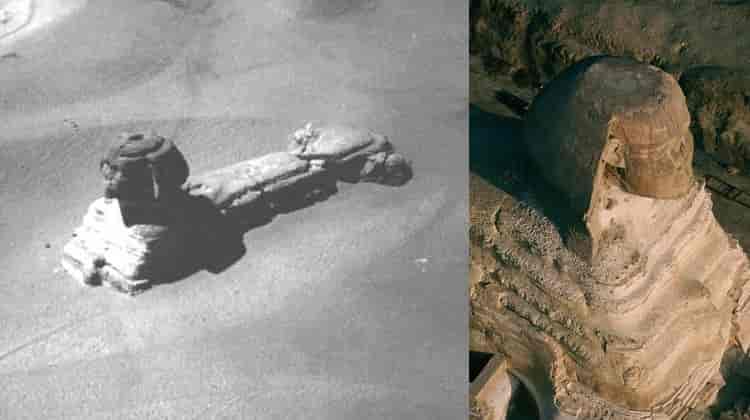The Sphinx of Giza, or the Great Sphinx of Giza, is a colossal monument that was constructed during ancient Egypt. It is located near the Pyramids of Egypt on the west bank of the River Nile, just outside Cairo.
The presence of the three pyramids (Khufu, Khafre, and Menkaure) and the Sphinx as a guardian makes the Giza Necropolis one of the most famous archaeological sites in Egypt, Africa, and the world.
The Great Sphinx is situated in the Giza Plateau in Egypt, Africa. Researchers believe that it was built around 2500 BC during the reign of Pharaoh Khafre. However, some argue that its age is much older, dating back to 10,000 BC.
The term “sphinx” is derived from the Egyptian language, “shesep ankh,” which means “living image.” In other words, it served as a guardian of the Giza Plateau, representing the Pharaoh’s strength.
History
Historical accounts suggest that the Sphinx was built with the head of Pharaoh Khafre. For the ancient Egyptians, it represented a deity: the Sun God, “Ra.”
Legend has it that around 1400 BC, Thutmose IV rested beside the Great Sphinx of Giza and had a dream about the Sun God, who asked him to remove the sand covering it. In return, the god would transform him into a great Pharaoh.
Between the lion’s massive paws, a red granite plate can be found describing this event. Some scholars believe it was originally painted red, but the color has faded over time.
Due to sandstorms, the Sphinx’s body remained completely covered for millennia, only being fully uncovered in 1925. Additionally, it has undergone multiple restoration efforts and is currently one of the most frequently visited monuments by tourists from all around the world.
Structure of the Great Sphinx of Giza
The Sphinx possesses a captivating structure rooted in a mythical figure, combining a lion’s body and a human head adorned with a real turban turned toward the rising sun. For the ancient Egyptians, the lion symbolized a significant protective entity.
Constructed from limestone, it boasts dimensions of 73 meters in length, 19 meters in width, and 20 meters in height, making it the largest Sphinx globally and also the largest statue crafted from a single colossal stone block.
Mysteries of the Great Sphinx of Giza
One of the most profound enigmas concerning the Sphinx pertains to the date of its construction and the perplexing loss of its one-meter-wide nose. Numerous hypotheses revolve around this conundrum, whether due to damage during one of the Napoleonic invasions or the erosion caused by the passage of time.
Is There Anything Inside the Sphinx?
The Great Sphinx of Giza was crafted by sculpting a limestone mound situated on the Giza plateau. It stands at a towering height of approximately twenty meters, with the face measuring more than five meters. The head is believed to represent Pharaoh Khafre, while its body takes the form of a lion.
Where is the Nose of the Great Sphinx of Giza?
Possible Explanations
Between 1798 and 1801, Egypt witnessed the Napoleonic conquest, during which French troops are believed to have damaged the nose of the Great Sphinx. This harm might have resulted from cannon fire or bullets targeting the ancient Egyptian monument.
It’s surprising that an army accompanied by a large group of scholars, who were set to publish the first major scientific work on Egyptology, “La Description de l’Égypte,” could be so insensitive to the pharaonic heritage as to damage it with their weapons.
Additionally, it’s important to note that the Sphinx of Giza is known to have been noseless even before Napoleon’s army arrived in Egypt. This fact is supported by drawings made by the Danish architect Norden Frederick Lewis Norden in 1737.
While in the same year, Englishman Richard Pococke made drawings of the Sphinx with its nose intact, it’s more plausible that Pococke exercised artistic license to depict the monument in its original condition rather than Norden inventing the absence of the olfactory organ.
The key to this mystery lies in a document by the 15th-century Arab historian Muhammad al-Husayni Taqi al-Din al-Maqrizi. In his book “al-Mawa’iz wa al-itibar fi dhikr al-khitat wa al-athar,” he recounts that the nose and ears were destroyed in 1378 by the Sufi leader Sa’im al-dahr.
He took offense at the Sphinx due to the devotion of the Egyptians to the monument and sought to “correct a religious error.” For his crime, Sa’im al-dah was charged with vandalism and executed, but the damage had already been done.
Incidentally, it’s worth mentioning that the chin found beneath the Sphinx’s head, currently housed in the British Museum in London, appears to have been added after the construction of the main monument. There are no signs of damage to the jaw that one would expect to find if it had been part of the original structure.






